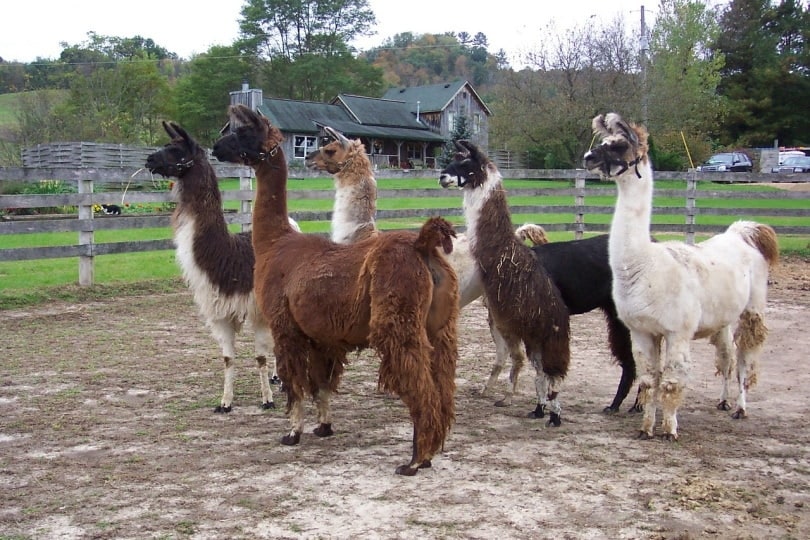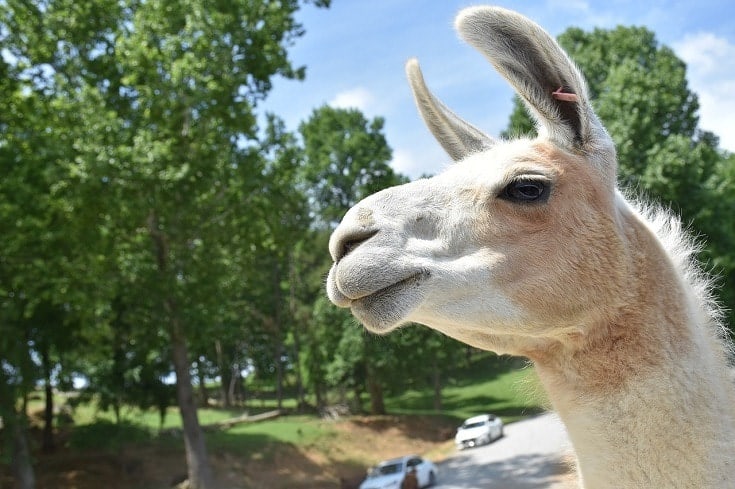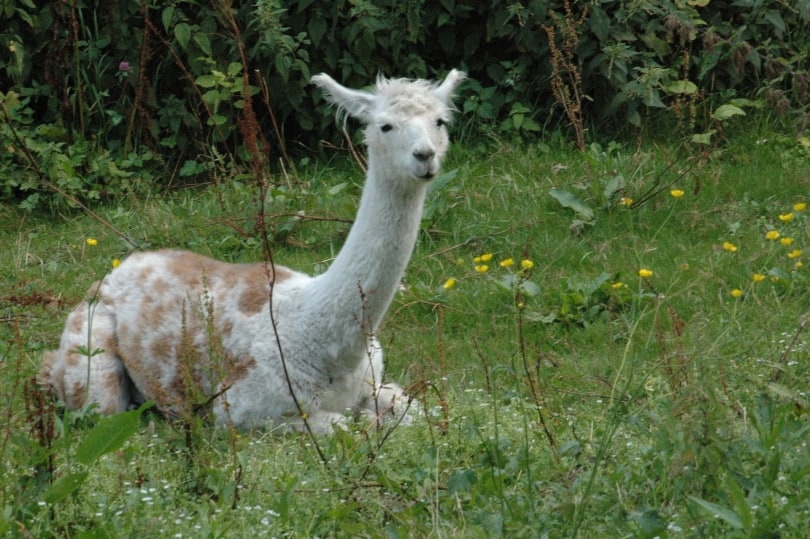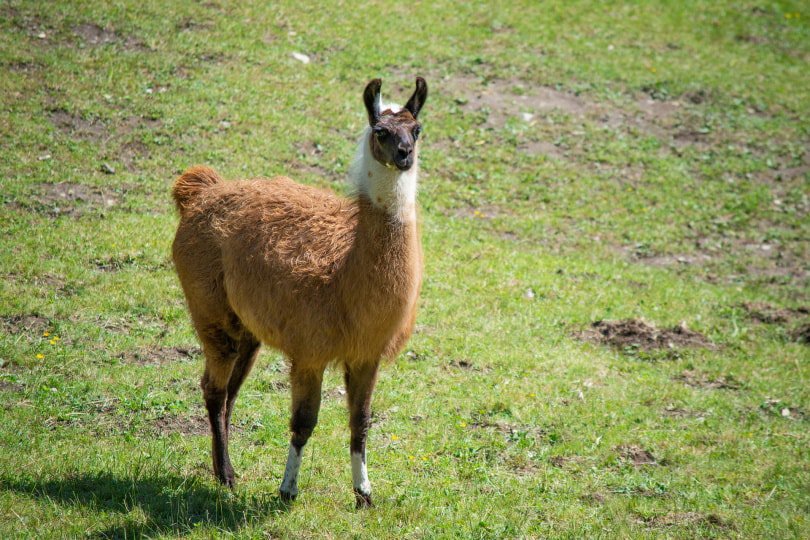If you’re captivated by llamas with their big soulful eyes, velvety snouts, and seriously funky haircuts, you may be thinking of buying one of these animals. Over the years, many Americans have become enamored with these fluffy gentle giants as well as with their cousins, the alpacas. In recent decades, the number of llamas living in the United States has skyrocketed.
As a pack animal, a llama can carry about a third of its body weight which typically means 50 to 100 pounds of well-balanced load. When compared to other pack animals like a donkey, horse, or camel, the llama lags in terms of weight carrying capacity simply because these animals are bigger and stronger. The llama’s cousin, the alpaca, is incapable of carrying much weight at all because its bone structure is not designed for heavy loads, plus it’s an animal that doesn’t like things placed on its back.
We’ve put together this price guide to help you learn how much llamas cost to buy and what to expect regarding the total cost of keeping one of these animals native to South America.

Bringing Home a New Llama: One-Time Costs

When you buy a llama from a trusted breeder, you can expect to get some sort of a warranty, updated vaccinations, a deworming, the animal’s medical history, nail cutting, shearing, and aftercare assistance if you ever need it. The costs of all these things are included in the actual price you’ll pay for the animal.
A llama can cost anywhere from a few hundred dollars up to $5,000, depending on a few factors. The factors that will help determine the actual cost include things like:
- Age
- Temperament
- Gender
- Breeder
- Wool Quality
- Training
- Lineage
- Purpose
Free
If you’re put off by having to spend several hundred to many thousands of dollars for a llama, you should know that it may be possible to get a llama for free. While it might not be easy to find a free llama, it would be worth any effort you put forth if you do end up finding a free one.
Unfortunately, many people who buy these big animals don’t realize they need tending to. You can’t just buy a llama and set it free on your property and expect the animal to thrive.
Use the internet and check for rescue llamas near you. If you’re lucky, you may run across a private individual who has a llama or even several they’d like to get rid of asap.
Adoption
$250–$300
Another way to save on a llama is to adopt one. This involves finding an animal rescue organization near you that has llamas up for adoption. Typically, all you’ll have to pay is the adoption fee.
The good thing about adopting a llama is that you don’t have to worry about getting a low-quality llama or one that has been neglected or abused. This is because most llamas arriving at rescue organizations arrive very healthy. These animals are usually given up because the owners simply can’t care for them. If a llama is sick when it arrives at a place of rescue, it will be restored to health before being offered for adoption.

Breeder
$500–$5,000
If you can afford to buy a llama at full price, it’s always best to look for a reputable llama breeder. This way, you’ll get a healthy animal that comes with all those extras mentioned above like health history, shots, deworming, etc. But before you buy a llama, do plenty of research.
It’s advisable to search the web, read books, and even visit some llama farms before you commit to buying. And by all means, ask lots of questions. A top-notch breeder will happily answer any questions you have and tell you all you need to know about caring for these majestic animals.
Initial Setup and Supplies
$200–$1,500
Of course, you’ll have to be ready to take your llama home once you’ve found one to buy. This means you must have money in your budget to cover some initial setup costs and supplies. For starters, you’ll need a shed or a three-sided shelter for your llama to protect the animal from the sun and rain. The shelter you build or buy should be large enough to allow your llama to move around freely.
In addition to a shelter, you’ll need to have a fence up to keep your llama safe and secure. If you don’t already have a fence, you can save money by making one from either board or split rail. The good news is that llamas tend to stay away from fencing. So your fence doesn’t have to be super robust, but it must be sound and secure!
You’ll also need to pick up some feeding hay and llama pellets. You can expect it to cost you about $250 per year to feed a llama, that includes the pellets and hay.
List of Llama Care Supplies and Costs
| Food-pellets & hay | $250 |
| Vaccinations | $50 |
| Bedding straw | $50 |
| On-site health check with a licensed vet | $65 |
| Microchip | $45–$55 |
| Nail clippers | $20 |
| Halter & lead | $30 |
| Brush (optional) | $10 |
| Food and water bowls | $20 |
How Much Does a Llama Cost Per Month?
$65–$160 per month
It will cost $65-$160 per month to care for a llama. This price will vary depending on the actual cost of the food and bedding you buy. The nice thing about keeping a llama is the low overall cost associated with this animal’s general care. Just be sure you have all your bases covered by picking up plenty of food and bedding. If you plan on taking your llama outside of their enclosure, be sure to pick up a sturdy halter and lead.

Health Care
$0–$50 per month
Aside from providing a llama with nutritious food, these animals don’t need much health care on a regular basis. One thing you will have to do if your llama will be grazing outdoors during the summer months is to have your vet come and give your animal an anti-parasite medication to protect it from meningeal worms. This is an infection that’s spread by deer in many areas. Otherwise, you won’t have to incur many monthly medical care costs.
Plan on shearing the llama’s wool coat each spring so your animal isn’t adversely affected by the summer’s heat. You can do this job yourself or pay someone $25–$35 to do it for you. As far as nail clipping goes, this should be done on an as-needed basis. If you’re uncomfortable handling clippers, the job can be done by your vet or someone with experience for around $20.
Food
$20–$30 per month
It’s not costly to keep a llama in pellets and feed hay each month because these animals are not big eaters. A large llama may consume about 20 bales of hay per year which isn’t much when you break it down by month. If you have the budget for it, you can supplement your llama’s diet with a special alpaca and llama nutritional supplement that costs around $40.
Grooming
$10–$25 per month
The only grooming you’ll have to do regularly is brushing your llama’s coat to keep the wool clean. This is especially important if you’re planning on showing your animal or taking it out in public. Other than brushing, you’ll need to clip your llama’s nails when needed and shear the animal during the spring.

Medications and Vet Visits
$10–$40 per month
Besides having your vet come to give your llama an anti-parasite medication in early summer, there are no monthly medications or vet visit costs to worry about. If your vet is the only person you know who can cut your llamas nails in case you don’t feel comfortable doing it, you’ll have to pay for that service which should be around $20, depending on your location and your vet’s fees.
Pet Insurance
$20–$40 per month
In terms of insurance, llamas are classified as exotic animals which means you’ll need exotic animal pet insurance. This type of insurance will cover your animal for theft, death, and vet fees associated with accidental injury or illness. You will need livestock insurance if you’re going to make money from your llama via breeding or selling their wool. Insurance rates vary considerably but plan on spending around $30 on average per month.
Environment Maintenance
$5–$15 per month
Your llama’s enclosure must be kept clean to make it a comfortable and safe place for your animal. This means you’ll have to regularly change the bedding straw you put down. Thankfully, straw is cheap to buy, and especially if you buy it in bulk, so stock up to keep your monthly costs down. Other than straw, there are no environmental maintenance costs to worry about when owning a llama.
Total Monthly Cost of Owning a Llama
$65–$160 per month
When you consider all the things you must do to keep your llama healthy and happy, you’ll end up spending anywhere from $65–$160 per month. One of the reasons owning llamas is popular today is the low overall cost of ownership, care, and maintenance. These big, goofy-looking animals are relatively easy to feed and care for which is a big plus if you’re on a budget.

Additional Costs to Factor In
There may be some additional costs you’ll have to cover when you have a llama. For example, you may need to hire someone to tend to your llama if you’re away a lot. You may also need to pay for animal training if your llama has some behavioral issues like aggressiveness.
Depending on your insurance policy, you may also have to cover an occasional vet bill if your llama gets sick or becomes injured. It’s best to always have some money set aside just in case something comes up!
Owning a Llama on a Budget
As stated earlier, llamas are not expensive animals to own. But if you’re out to save as much money as possible, shop around for the llama feed, hay, and straw you need and always buy it in bulk!
When you’re looking for a llama to buy, always check to be sure any animal you’re interested in is well-trained. This can save you a bundle on animal training in the future. And make sure you use a breeder that is honest with you regarding the animal’s health history so you don’t run into any medical issues later that will cost a fortune.

Saving Money on Llama Care
The best way to save money on llama care is to learn how to do things yourself. For example, you can save on shearing and nail clipping costs by having someone with experience show you how to do these tasks. Another way to save on llama care is to purchase a very good insurance policy with comprehensive coverage so you don’t get stuck with big vet bills.
Summary
As you can see, owning a llama does cost a considerable amount of money when you factor in the purchase price along with the average monthly costs covering things like grooming and food. However, compared to other large exotic pets, llamas are cheap to own and care for.
Take your time when choosing a llama to ensure the animal you take home is healthy and well-trained. And use some common sense when buying feed and supplies so you can nab the best possible deals. Be sure to buy your feed, hay, and straw in bulk to save yourself a considerable amount of money!
Featured Image Credit: Pezibear, Pixabay
